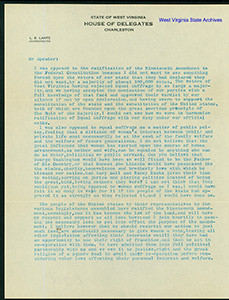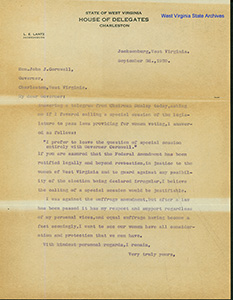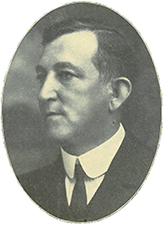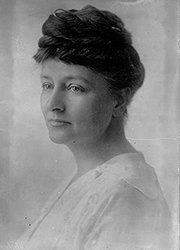

Chapter Seven |
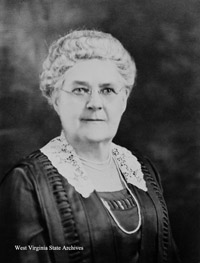 Harriet B. Jones. Boyd B. Stutler Collection, West Virginia State Archives |
On August 26, the same day United States Secretary of State Bainbridge Colby certified the Susan B. Anthony Amendment as part of the U.S. Constitution, the first local League of Women Voters in West Virginia was organized in Marshall County at the courthouse in Moundsville. Dr. Harriet B. Jones, long a supporter of woman suffrage, served as chair of the meeting in which a constitution and bylaws were adopted and a board of directors was elected. At the meeting, 54 women joined the local league.
A week later, the organization held a mock election at which more than 100 women participated. Women were given instruction on registration and voting. Jones was the first woman to vote in the mock election and "the first to break the rules, she having carried the pencil away with her." (Moundsville Daily Echo, September 3, 1920) |
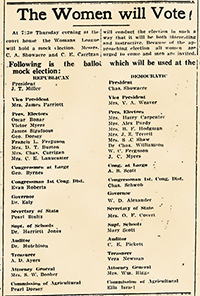 Mock Ballot, Moundsville Daily Echo, September 1, 1920 |
|
"[W]e are now confronted with the situation I feared--the women enfranchised but not registered, and a provision in the statute making registration a condition precedent to exercising the right of suffrage." |
The day after Secretary of State Colby certified the 19th Amendment, Governor John Cornwell wrote a letter to the attorney general seeking a legal opinion on registration of women voters. Cornwell had included enactment of legislation to register women in his message to the legislature the previous March; however, that body had failed to take action on the registration of women during the special session even though Delegate John had introduced bills to address the matter. The existing law provided for a two-day process to amend and complete the registration of voters. The reply from the Attorney General's Office left it to the governor: "As to the practicability of the registering of the women under our present laws, and thus meeting the present unusual situation, I would defer to your good judgment, as that would not be a question of law, but one of practical administration." (The West Virginian, August 30, 1920) Initially, Cornwell did not intend to call a special session but to let registration be handled under existing provisions. However, difference of opinion about the feasibility of registering women in two days led the governor to call a special session in September. |
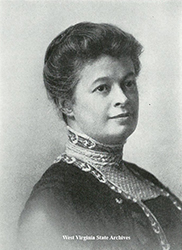 Julia Ruhl, The Silver Gleam, Sc2014-019, West Virginia State Archives |
At the end of September, the last convention of the West Virginia Equal Suffrage Association was held in Huntington, followed by inauguration of the West Virginia League of Women Voters. Presiding at the WVESA convention, Ruhl advised the hundreds of women attendance, "if we are to be worthy we must work as we have worked before, inspired by the highest motives, and using our every influence to make America better by voting." (Huntington Advertiser, September 29, 1920)
Ruhl was made the first chairman of the West Virginia League of Women Voters. Other officers were Mary C. Burks of Huntington, vice chairman; Mrs. J. B. Stratton of Williamson, secretary; and Mrs. H. D. Rummell of Charleston, treasurer. These women were to serve on the board of directors as were Dr. Harriet B. Jones of Glen Dale, Mrs. W. L. Lipscomb of Parsons, Mrs. Orlandus West of Clarksburg, Mrs. Izetta Brown of Kingwood, Elsie Murphy of Charles Town, and Mrs. John A. Shields of Welch. Henrietta Romine of Wheeling was made chair of the legislative committee. In addition to pledging themselves to vote on election day, the West Virginia organization endorsed the Good Roads Amendment to the state constitution. |
On the last day of the Huntington gathering, Marie B. Ames of St. Louis, who had conducted them elsewhere in the country, held a citizenship school. She would provide additional schools in the state in the coming weeks. Women also were given the opportunity to learn about important political issues such as the League of Nations.
Throughout most of October, West Virginia women registered to vote. Total numbers for registered women in the state are not available, but according to newspaper accounts, in Monongalia County, more than 7,400 of the total 16,571 registered voters in the county were women. When there were two days left in the registration period, more than 12,500 women already had registered in Marion County. By the time registration was completed, the number of women registered to vote in Ohio County exceeded that of men by 222: 18,161 women and 17,939 men.
On November 2, West Virginia women voted for the first time. Some estimates suggest that, nationwide, roughly 35 to 40 percent of women voted. Newspaper reports of turnout among women in West Virginia's urban areas were good even though it rained on election day, sometimes heavily. According to The Suffragist, based on reports from National Woman's Party state chairmen, about 200,000 women voted in West Virginia, which would translate to around 39 percent of total voters.
The election in Shepherdstown was interesting, but peaceful. Both parties were very active, but there was an absence of some of the objectionable tactics that have been observed in days gone by. The electioneering was lively, both men and women being busy from early in the morning until the polls closed late in the evening, and automobiles were running all day long, bringing in voters from town and country. It cannot be denied that the enfranchisement of women has had a beneficial effect upon the election proceedings, and there was absolutely no disorder about the polls or indeed in any part of the town. . . . Women clerks were employed at each voting place, attending to their duties in the most satisfactory manner. It was an entirely novel sight to see women helping to manage the election, for such a thing had never before been known in this country. . . .The town women were more willing to vote, apparently, than those living in the country. They voted with as much ease as the men and required comparatively little instruction from the clerks. (Shepherdstown Register, November 4, 1920.
Primary Documents:
Women Party Officials, 1920"Local Women Organize for Voting," 1920
"Women Will be Registered as Law Now Says," 1920
"Mrs. Yost Says West Virginia Women Will Be Registered," 1920
The New Registration Law, 1920
Welcome Remarks of Nancy Mann to West Virginia Equal Suffrage Association, 1920
"West Virginia's New Voters: Their Duties and Responsibilities When They Cast Their First Ballots," 1920

